The
holy Martyr-King Oswald was born in the year 604, being
the son of the pagan King Aethelfrith of Bernicia . In 616,
following on the death of his father, he was forced to flee
with his six brothers and sister St. Ebba to exile in
Scotland , where they were received with honour by King
Donald Brecc. There he received the faith of Christ and was
baptized on the holy island of Iona .

In 633, shortly after the death of King Edwin at the hands
of Kings Cadwallon of Gwyneth and Penda of Mercia, and the
apostasy of almost all the Northumbrians from the Christian
Faith, Oswald advanced south with a small force into English
territory. He was met by a vastly larger army under King
Cadwallon at Heavenfield near Chollerford on Hadrian's Wall.
On the eve of the battle, as St. Columba's biographer, St.
Adomnan, writes: "while King Oswald, after pitching his camp
in readiness for the battle, was sleeping on a pillow in his
tent, he saw St. Columba in a vision, beaming with angelic
brightness, and of a figure so majestic that his head seemed
to touch the clouds. The blessed man, having announced his
name to the king, stood in the midst of the camp, and
covered it all with his brilliant garment, except at one
small distant point; and at the same time he uttered those
words which the Lord spake to Joshua the son of Nun before
the passage of the Jordan, after Moses' death, saying: 'Be
strong and of good courage; behold, I shall be with thee.'
Then St. Columba, having said these words to the king in the
vision, added. 'March out this following night from your
camp to battle, for on this occasion the Lord has granted to
me that your foes shall be put to flight, that your enemy
Catwallon shall be delivered into your hands, and that after
the battle you shall return in triumph.' The king, awaking
at these words, assembled his council and related the vision,
at which they were all encouraged; and so the whole people
promised that, after their return from the war, they would
believe and be baptized, for up to that time all that Saxon
land had been wrapped in the darkness of paganism and
ignorance, with the exception of King Oswald and the twelve
men who had been baptized with him during his exile among
the Scots.
"I, Adamnan, had this narrative from the lips of my
predecessor, the Abbot Failbe, who solemnly declared that he
himself had heard King Oswald relating this same vision to
Segine the abbot."
The Venerable Bede continues the story: "On approaching the
battle Oswald set up the sign of the holy cross and on
bended knees besought God to send heavenly aid to His
worshippers in the hour of their need; and the place is
pointed out to this day and held in great reverence. Indeed
it is said that when the cross had been quickly made and a
hole made ready for it to stand in, Oswald himself, fired by
his faith, seized it and placed it in its hole and held it
upright with both hands, until the soldiers heaped up the
soil and made it fast in the ground. Thereupon he raised his
voice and cried aloud to the whole army: 'Let us all kneel,
and together pray the almighty, true and ever-living God to
defend us by His mercy from a proud and cruel enemy; for He
knows that the war we have engaged in for the deliverance of
our people is a just war.' They all did as he had ordered
and, advancing thus against the enemy as dawn appeared, won
the victory as the reward for their faith. At the place
where they prayed countless miracles of healing are known to
have been wrought, a sure proof and memorial of the king's
faith."
Although the remnants of the St. Paulinus' mission to
Northumbria still existed under the leadership of Deacon
James, St. Oswald preferred to send to Iona for missionaries
to reconvert his newly-won kingdom. When the Irish bishop St.
Aidan arrived, continues Bede, "the king granted him the
island of Lindisfarne, as he requested, to be his episcopal
see. With the ebb and flow of the tide, this is a place that
is twice a day encircled by the waves of the sea, like and
island, and twice rejoined to the mainland when its shore
becomes exposed again. In all matters Oswald listened humbly
and joyfully to the bishop's advice, and showed great
concern to build up and extend the Church of Christ within
his kingdom. The bishop was not fully conversant with the
English language, and on many occasions it was delightful to
watch while he preached the Gospel and the king himself,
having acquired a perfect knowledge of Irish during his long
exile, acted as interpreter of heaven's word for his
aldermen and thanes.
"From that time many missionaries from Irish territory began
to arrive in Britain as the days went by, who preached the
word of the faith with great zeal to the English kingdoms
ruled by Oswald; and to those who believed, such of them as
held the rank of priest administered the grace of baptism.
Churches were built in various places, and the people gladly
flocked together the hear the Word. By the gift of the king
estates and lands were granted for the establishment of
monasteries, and English boys together with their elders
were given systematic instruction by Irish teachers and
taught to observe the discipline of a Rule."
From Lindisfarne many monasteries were built in various
parts of the north. Thus there was Melrose, where the great
St. Cuthbert became a monk, Hartlepool, where the first
abbess was Heiu "the first woman in the kingdom of the
Northumbrians to take the vows and habit of the religious
life", Coldingham, where Oswald's sister St. Ebba was the
first abbess, and Whitby, where St. Hilda was the first
abbess. Oswald also strengthened the faith in Wessex, where
he became godfather of the first Christian king Cynigils and
married his daughter.
St. Oswald, writes Bede, "was always humble, kind and
generous towards the poor and towards strangers. For example,
it is said that once at Pascha, when he was sitting at
dinner with the bishop, and a silver dish was placed before
him on the table full of royal fare, they were about to
raise their hands to ask a blessing on the bread when one of
his officers, whose duty it was to bring relief to the needy,
suddenly came in and told the king that a large crowd of
poor people from every district was sitting in the precincts,
asking for alms from the king. He at once ordered the meal
that had been served to him to be taken out to the poor, and
the dish to be broken in pieces and divided among them. When
he saw it, the bishop who sat with him was delighted by the
act of mercy, and took his right hand and said: 'May this
hand never wither with age.' And his prayer and blessing
were fulfilled, for when Oswald was killed in battle his
hand and arm were severed from his body, and they remain
undecayed to this day. They are preserved in the royal town
named after Bebba, a former queen, stored in a silver casket
in the church of St. Peter, and are venerated with due
honour by everyone."
Bede also records that St. Oswald was a great zealot of
prayer. Thus "it is said, for example, that he often
remained at his prayers from the time of the office of
Mattins until daybreak, and because of his frequent habit of
prayer and giving thanks to God, wherever he sat he used to
have his hands on his kness with the palms upward."
St. Oswald subdued the kingdom of the Mercians and drove the
pagan King Penda into exile in Wales. However, in 642 Penda
gathered a large heathen army and, allying himself with the
Welsh ruler of the mid-Severn valley Cynddylan, he
unexpectedly attacked Oswald near Oswestry. "But the man of
God," writes Reginald of Durham, "hitherto renowned for his
honour as a soldier, refused to consider flight, in case he
should seem a man unskilled in the conduct of battle. He
considered it dishonourable to be found vanquished and
disgraced at the end, when hitherto he had appeared to all
to be a vigorous and victorious warrior. And so he summoned
a small force of soldiers and proceeded to commit himself to
Christ, gladly choosing to die for the honour of the Lord
and the faith of the Cross, and for the salvation and
freedom of his Christian people... He therefore advanced to
battle with great confidence, seeing that he was summoned by
the Lord's mercy to a martyr's crown. Penda had gathered a
large force of the heathen, and suddenly advanced to the
field of battle, where he slaughtered a great number of the
Christian people together with their holy and most Christian
king."
Bede records that when the saint "saw that he was surrounded
by enemy forces and about to be slain, he prayed for the
souls of his army; and this is the origin of the proverb, 'God
have mercy on their souls, said Oswald falling to the ground'."
Penda took the saint's head and hands and fixed them on
stakes for a whole year, to be an object of derision and
scorn. But his head was later retrieved by his brother Oswy,
and was placed in St. Cuthbert's coffin, where it still
remains. And his right hand - the one St. Aidan had blessed
- was placed in a silver casket at Bambrough, where it
remained completely incorrupt until at least the twelfth
century, as both Abbot Aelfric and Simeon of Durham attest.
At the place where he died - praying, with arms outstretched,
for the souls of his men - many miracles were wrought.
People took dust from the place and, mixing it with water,
applied it with wonderful effect to sick men and animals.
Once a house caught fire and burned down, and only the post
on which some of the holy dust had been placed remained
completely untouched.
In the year 697 Queen Ostrythe of Mercia, who was the
saint's niece, and was later murdered herself, decided with
her husband King Ethelred to translate the relics of the
saint to the monastery of Bardney in Lindsey (Lincolnshire).
But the monks of that monastery, entertaining a grudge
against Oswald because he had once been king over that
region, refused to allow the relics through the monastery
gates. So they remained on a waggon covered by a tent
throughout the night.
However, during the night a great column of light was seen
stretching from the waggon up to heaven, which was visible
throughout Lindsey. Chastened, the monks brought the holy
relics inside the gates, washed them with reverence, and
placed them in a specially constructed shrine in the church
with a gold and purple banner over it. The water used in the
washing was poured away in a corner; but the earth which had
received it was found to have the power of expelling demons.
Reginald describes the appearance of the head in the twelfth
century as follows: "The roundness of the head, completely
spherical, is extraordinary, and gives off a wonderfully
sweet fragrance; it has a glassy colour, glowing a deep
yellow all over which surpasses the yellowness of wax and is
closer, in its great beauty and loveliness and in its
gleaming brightness, to the appearance of gold. It is a
sphere of large dimensions, in width, in length, and from
front to back; and a smooth line, like the circle of a
helmet, rises and falls around the middle of its curvature.
Its bulk is considerable, but... when held in the hands it
seems quite light, although to the eyes observers, judging
by its size, it looks a heavy weight. The forehead is broad
and prominent, the nose of moderate proportions. The length
of the face and cheeks lend the face a certain nobility,
clear testimony to his manly glory."
His fame quickly spread throughout the British Isles and
into continental Europe, where relics of his body, including
fragments of the wooden cross he erected at Heavenfield and
earth taken from his grave, worked many miracles, several of
which are recorded by the Venerable Bede. One of these took
place at a monastery founded by St. Wilfrid in Sussex in the
second half of the seventh century: "About the time that
this province accepted the Faith of Christ, a dangerous
epidemic struck many provinces of Britain. When, by God's
dispensation, it reached the monastery, ruled at the time by
the most religious priest of Christ, Eappa, it swept from
this life many of the brethren, some of whom had come with
the bishop, while others were South Saxons recently
converted to the Faith. The brethren therefore decided to
observe a three-day fast and implore God in His mercy to
show pity on them, that He would preserve those who were in
danger of death by disease, and deliver the souls of those
already departed this life from eternal damnation.
"In the monastery at this time there lived a little Saxon
boy, who had recently been converted to the Faith; this
child had caught the disease, and for a long time had been
confined to bed. About the second hour on the second day of
prayer and fasting, he was alone in the place where he lay
sick, when, by Divine Providence, the most blessed Princes
of the Apostles [Peter and Paul] deigned to appear to him;
for he was a boy of innocent and gentle disposition, who
sincerely believed the truths of the Faith that had been
accepted. The Apostles greeted him very lovingly, and said:
'Son, put aside the fear of death that is troubling you; for
today we are going to take you with us to the Kingdom of
heaven. But first of all you must wait until the Liturgies
have been celebrated, and you have received the Viaticum of
the Body and Blood of our Lord. Then you will be set free
from sickness and death, and carried up to the endless joys
of heaven. So call the priest Eappa, and tell him that our
Lord has heard the prayers of the brethren and regarded
their fasting and devotion with favour. No-one else in this
monastery and its possessions is to die of this disease, and
all who are now suffering from it will recover and be
restored to their former health. You alone are to be set
free by death today, and will be taken to heaven to see the
Lord Christ Whom you have served so faithfully. God in His
mercy has granted you this favour through the intercession
of the devout King Oswald, so beloved by God, who once ruled
the people of the Northumbrians with outstanding devotion as
their early king and whose Christian piety has won him an
everlasting kingdom. For today is the anniversary of the
king's death in battle at the hands of the heathen, when he
was taken up to the joys of the souls in heaven and enrolled
among the company of the saints. If the brethren consult the
annals that record the burials of the dead, they will find
that this is the day on which he departed this life, as we
have said. So let them celebrated Liturgies in all the
oratories of the monastery, either in thanksgiving for God's
answer to their prayers, or in commemoration of King Oswald
the former ruler of their nation, who has prayed for them as
newcomers of his nation. Let all the brethren assemble in
church, and join in offering the heavenly Sacrifice; and let
them end their fast and take food to restore their
strength.'
"When the boy had called Eappa and told him all that the
Apostles had said, the priest particularly asked him to
describe the clothes and appearance of these men who had
appeared to him. 'They wore wonderful robes,' the boy
replied, 'and their faces were very kindly and handsome,
such as I have never seen before. I did not believe that
there could be men so distinguished and wonderful. One of
them was tonsured like a priest and the other had a long
beard; and they said that one of them was Peter and the
other Paul, and that they were servants of our Lord and
Saviour Jesus Christ, sent by Him to protect our monastery.'
The priest then believed the boy's statement, and went off
at once to consult his annals, where he found that King
Oswald had indeed been killed on that very day [August 5].
So he summoned the brethren, ordered a meal to be prepared,
Liturgies to be celebrated, and all the brethren to
communicate as usual. He also directed that a particle of
the Lord's Offering should be taken to the sick boy at the
time of the holy Sacrifice.
"A little while later the same day the boy died, and his
death proved the truth of what Christ's Apostles had told
him. In further confirmation of his statement, no-one except
himself died in the monastery at that time. Many who heard
about the vision were wonderfully inspired to implore God's
mercy in every trouble, and to adopt the wholesome remedy of
fasting. And from that time the heavenly birthday of
Christ's warrior King Oswald was commemorated each year by
the offering of Liturgies, not only in this monastery but in
many other places as well."
St. Oswald is commemorated on August 3 and October 8.
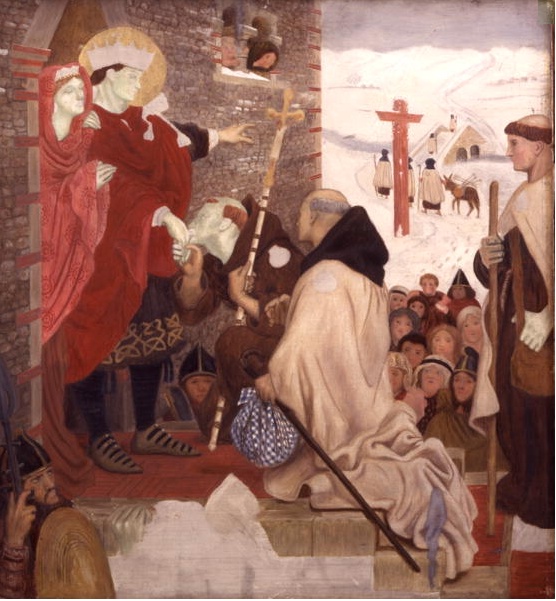 Saint Aidan and Saint-King Oswald
Saint Aidan and Saint-King Oswald
~~~~~~~~~~~~~~~~~~~~~~~~
Oswald was born at the beginning of the 7th century. He was
the youngest son of the pagan Ethelfrid, first king of a
united Northumbria. After his father's death in battle, the
young Oswald fled to Iona for safety and there he was
baptised and became a Christian. In 633 Oswald returned to
Northumbria to regain his father's kingdom.
It was said that he set up a wooden cross as his standard
and dedicated himself and his people to God's protection
before engaging in battle with the occupying Welsh king,
Cadwallon, not far from Hexham.
The Battle of Heavenfield AD 635
Heavenfield is in the Northumbrian countryside just north of
Hexham and on the Roman Wall. Today at the spot where the
two forces met there is a wooden cross commemorating the
ancient battle.
A church dedicated to St Oswald has been built on the site
where King Oswald erected his cross.
Before the battle Oswald ordered his men to make up a wooden
cross. He held the cross upright in a hole while his
soldiers heaped soil around it. Then they all knelt down and
prayed for God to help them defeat Cadwalllon. It is said
that St Columba appeared to Oswald and told him to be strong
and to be of good courage.
Oswald defeated and killed Cadwallon and
at once invited monks from Iona to begin the work of
evangelisation of his kingdom which extended from the
Forth to the Humber.
There is a tradition that Oswald was crowned king on
what is now known as the Lawe Top at South Shields and
in the olden days it was known as Oswald's Hill.
The battle re-established a Christian as King of
Northumbria and one of Oswald's first tasks was to
invite the monks of Iona to set up a monastery in the
region. This they did at Holy Island under the guidance
of St Aidan and from here Christianity spread to be the
main religion of the nation.
Oswald found Aidan to be both a valued adviser and a
good friend.
Oswald often accompanied Aidan on his missionary
journeys, acting as interpreter for at first Aidan could
not speak the local dialect. Aidan was noted for his
prayerfulness and his charity to the poor.
Killed in battle
Sadly the reign of Oswald lasted only
eight years. On August 5th 642 he was killed in battle
by Penda, king of the Mercians at Maserfield, now
Oswestry, in Shropshire.
St Oswald's feast is celebrated on 3rd
August.

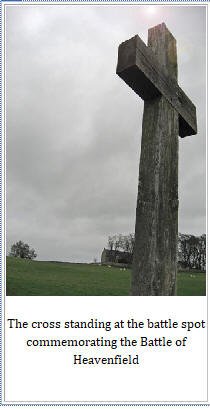
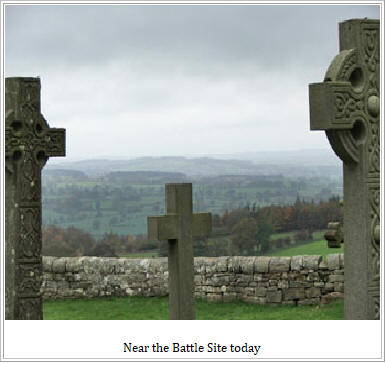
~~~~~~~~~~~~~~~~~~~~~~~~
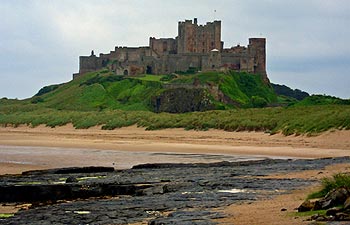 Bamburgh Castle,
Northumberland
Bamburgh Castle,
Northumberland
Bamburgh is one of the most spectacular of England’s
coastal castles, with a long and complex history.
Some important early medieval archaeology survives
below the Norman castle that we see today.
Excavations in the 1970s and more recently show that
the site was one of the key strongholds of
Anglo-Saxon Northumbria. The outcrop of basalt rock
(known as the Whin Sill) on which it is built was
occupied from around AD 500, and recent excavations
have revealed part of what may be the entrance of
the early structure, and the stonewall that defended
it.
A castle was probably first built on the site in the
sixth century, and was a part of the forward
frontier separating England from Scotland. It is
traditionally said to have been founded in 547 by
King Ida, one of the first Anglian rulers of the
north. The name means 'Bebbe’s fort' - probably
taken from the name of Ida's grandson's queen - the
grandson being King Aethelfrith of Bernicia
(593-617). Part of a pagan Anglian cemetery has
recently been excavated outside the castle walls.
Bamburgh was particularly important under Oswald
(king and saint), who succeeded Aethelfrith and
converted to Christianity. The twin centres of
Bamburgh and the monastery of nearby Lindisfarne
were to be the focus of the Northumbrian golden age
in the seventh and eighth centuries, and the
excavations have found evidence of high status
metal-working, some gold work, and part of a stone
chair or throne.
The early structure has long gone, and what remains
today is a great Norman keep (dating to c.1120), and
a series of bailies contained within the curtain
walls. In 1610, with the unification of the Scottish
and English crowns accomplished, and the frontier no
longer significant, the castle was sold to the local
Forster family, who stripped it of its materials. In
1704 it was bought by Lord Crewe, Bishop of Durham,
and it was used at different times as a school, a
hospital and accommodation for shipwrecked sailors.
The structure's modern restoration as a 'fairy-tale'
castle dates to 1894-1905, and was undertaken after
it was purchased by Sir William Armstrong, a wealthy
Victorian industrialist. The interiors today are
heavily panelled, and full of Edwardian gloom. Apart
from the keep itself, the only significant medieval
rooms are the kitchens and cellars.
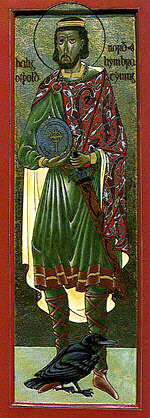

 Saint Aidan and Saint-King Oswald
Saint Aidan and Saint-King Oswald



 Bamburgh Castle,
Northumberland
Bamburgh Castle,
Northumberland